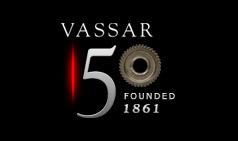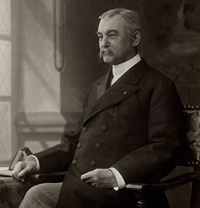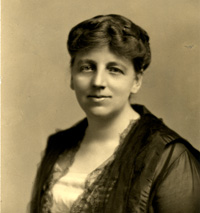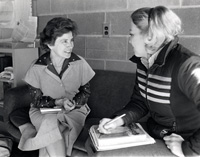The History of French and Francophone Studies at Vassar College
by Christine Reno, Professor 1
May 2011
Program Website
French was one of the original disciplines studied at Vassar Female College. Its courses were housed in the Department of Ancient and Modern Languages and Literature, one of the eight departments listed in the First Annual Catalogue. French was the most popular foreign language taught in Vassar’s early days, surpassing Greek, Latin, German, Italian and Spanish (An Administrative History, p. 28). Prospective students wishing to skip the preparatory program and pursue Vassar’s “Regular Course” had to possess, among other competencies, a solid foundation in French. They had to demonstrate a mastery of “French Grammar, entire, embracing all irregular verbs, together with exercises, and some elementary prose pieces” (First Annual Catalogue, p. 1). The catalogue of 1878-79 gives a more detailed idea of the performance expected of “Regular Course” aspirants: in addition to knowing the rules of grammar and verbal forms, they had to translate passages from French to English and vice versa, including tricky sentences like:
“The French language is harder than I thought.”
“The little humming-birds which I came to see have escaped from their cages.”
“That hat would be very becoming, if you were a little taller.” (Fourteenth Annual Catalogue 1878-1879, p. 28).
Vassar’s first professor of French was the brilliant linguist William Ireland Knapp, who remained only two years, leaving to pursue his career in Europe, and eventually returning home to teach at Yale and the University of Chicago. In her Golden Age of Vassar, Mary Harriott Norris, one of Vassar’s first students, reminisced that Knapp “was a delightful instructor and much beloved, and it was our ambition to please him” (p. 48). A prolific scholar of both French and Spanish literature, Knapp set a high standard for generations of dedicated teacher-scholars to follow. These include Gertrude Schoepperle Loomis, a young American who taught in the department from 1919-1921, dying tragically from peritonitis at age 29. Shoepperle had obtained her doctorate in France under the direction of the great medievalist Joseph Bédier, and published several seminal articles on medieval French and Celtic literature; her Tristan and Isolt, A Study of the Sources of the Romance (1 913) remains one of the key works on the Celtic influences on medieval French romance. Florence Donnell White (taught 1908-1947) has been credited with reviving American interest in Voltaire; her 1915 study and edition of Voltaire’s Essay on Epic Poetry was most recently reprinted in 2010. White was also instrumental in setting up one of the early study-abroad programs through the Institute of International Education; she was, in addition, one of the very few Americans ever awarded France’s highest decoration, the Legion of Honor.
After White, many other exemplary faculty would continue to shape the department through the twentieth and into the twenty-first century. Ilse Hempel Lipschutz (taught 1951-1992), undoubtedly the department’s most beloved and multilingual figure in recent memory, did groundbreaking research on the influence of Spanish art on the French Romantic movement (Spanish Painting and the French Romantics), and was also a renowned expert on the nineteenth-century writer Théophile Gautier.
Adrienne Hytier, who taught in the department from 1959-1996, was a pioneer in the oral history of the Second World War (Two Years of French Foreign Policy: Vichy 1940-1942), and for decades was editor for The Eighteenth Century: a Current Bibliography. Anne Iker Gittleman (1954-1987), a student of the eminent medievalist Félix Lecoy, was an exacting and influential reviewer and spent a large part of her career editing the twenty-four manuscripts of the monumental epic poem Garin le Loherenc, which the French government crowned with a literary prize. Elisabeth Cardonne-Arlyck, recently retired, is a prominent critic of contemporary French poetry, prose and cinema, and was invited to teach at the Sorbonne Nouvelle in Paris; she continues her very active scholarly career in retirement.
Vassar’s first catalogue describes required study of French at Vassar as “enough to enable [students] to read, write and speak the language.” The early program included four semesters of reading, translation, conversation, and the history of French language and literature, with a focus on modern works. Elective courses in French were possible in the third year, and as early as 1866, there was a French Table in Main where students could get extra practice in conversation while dining.
By the third year of the college’s operation (1867-68), the “Regular Course” had divided into “Classical” and “Scientific” courses of study, with French being taught in both. In the Classical track, French was taken in the third year, advanced grammar providing the focus for the first semester and one of two seventeenth-century plays read in the second: Molière’s Tartuffe, a play about religious hypocrites, or Racine’s edifying Athalie. The “Scientific” Course included obligatory French courses for three of the four years, with a choice of French, German or Italian literature in the second semester of senior year. In the first three years, students pursuing the Scientific track mastered various texts on grammar, vocabulary and composition, moving on to translation and plays by Molière, Racine and Scribe and works by the novelist Emile Souvestre and the satirist Rodolphe Töpffer.
Succeeding catalogues give testimony to the expansion of the French curriculum, parallel to that of other departments. Numerous required courses and electives were added, the latter including Old French, the study of sixteenth-century authors, especially Montaigne and Amyot, two different seventeenth-century theater courses, and seventeenth-century philosophical literature.
In academic year 1870-1871 (that would mark France’s defeat in the Franco-Prussian war), a year of Latin, Greek or German at Vassar could be substituted for the French entrance requirement.2 In 1875, French and German split off from Anc ient and Modern Languages and formed a joint department; French became an independent department in 1901 (An Administrative History, p. 28).
During World War II, being a member of the French department entailed considerably more than teaching and research. Department members became vigorously involved in collecting money and clothing for French war victims, soliciting aid both on campus and in the wider Poughkeepsie community. Prof. Margaret de Schweinitz (’12), a Ronsard scholar who had worked with the Red Cross during the First World War, was given a year and a half leave to engage in relief efforts in Europe, especially for children. Before leaving campus, de Schweinitz was instrumental in the creation of a new multidisciplinary major in “Problems and Principles of Reconstruction” that was offered between 1943 and 1946.
The curriculum has evolved substantially in the succeeding decades, the most significant development since the 1980s being the increased emphasis on the culture and literature of French-speaking regions outside of France. Since the 1990s, intermediate and advanced offerings in Francophone literatures and cultures have become standard courses in the curriculum, and Francophone texts are regularly included as well in courses such as the short story, cinema, theater and several senior seminars. Immediately after the Haitian earthquake in January, 2010, the department organized an interdepartmental course on Haitian history, literature, politics and environmental policies that met from March-May. The importance of Francophone literatures and cultures in the curriculum is reflected in the department’s name change to “French and Francophone Studies” in 2008.
The department has traditionally encouraged study abroad in order to gain fluency as well as first-hand knowledge of French culture; the first published mention of this policy occurs in the Catalogue of 1929-1930 (p. 100). Since the late 1940s, the department has partially funded a large number of Vassarites studying abroad, first through the Florence Donnell White fund established by students and friends upon White’s retirement in 1947. Further support for study abroad has been provided since 1984 by the Dorothy Persh Prize for Summer Study established by Ms. Persh, a local teacher who devoted many of her retirement years to learning French at Vassar. The Gabrielle Snyder Beck Prize to encourage summer study in France was established in 1989 by Mrs. Beck’s son in honor of his French-born mother, a VC graduate of the class of 1895.
After sending students for decades to study French on the Sweet Briar Junior Year in France program, Vassar joined Wesleyan University’s well established program in Paris in 1997, and since then the majority of students of French studying abroad have done so on the Vassar-Wesleyan Program. The Program offers a combination of internal courses taught by French professors as well as courses in different branches of the University of Paris, the Collège International de Philosophie and the Institut d’études politiques (“Sciences Po”). In recent years, students have also had the opportunity to study in other French-speaking countries and regions, on programs in Morocco, Senegal, Cameroon, Switzerland and Quebec. Since last year, the department has also sponsored a small program in Bordeaux.
The French department has a long history of inviting prominent French and Francophone writers, intellectuals and activists to campus. Among the most famous of these are André Maurois (1931), Vercors (1941), Julien Green (1943), Philippe Soupault (1945), Albert Camus (1946), Simone de Beauvoir (1947, see below), Alain Robbe Grillet (1964), Fernando Arrabal (1977), Hélène Cixous (1981), Michel Deguy (1985), Assia Djebar (1986), Maryse Condé (1992), Benjamin Stora (1993), Jean-François Sirinelli (1994), Malek Chebel (1995), Annie Cohen-Solal (1996), Henri Alleg (2007) and Edouard Glissant (2007). The feminist novelist and activist Monique Wittig taught in the French department, as well as in Philosophy and Women’s Studies, in 1988-89. The department also regularly invites prominent literary and cultural scholars and historia ns, and organizes events aimed at fostering student-faculty interaction. Most prominent among these are the “Café français,” a weekly conversation hour with the French language fellow; the “Salons,” in which students and faculty present their research in a congenial setting; a student-faculty book club; and this year’s Tournées Film Festival, that brought students and faculty together with members of the community to view and discuss recent French films.
Simone de Beauvoir memorialized her visit to Vassar in her book L’Amérique au jour le jour (America Day by Day), after her three-month tour of the U. S. in 1947. In the entries for February 7 and 8, de Beauvoir, no doubt astonished by the quantity of snow that met her eyes, compares the snow-covered Poughkeepsie houses to chalets in Megève. She is charmed by the good looks of the “college girls,” startled by their multitasking as knitting needles click away during her lecture, and disappointed by the French faculty who, inexplicably, offer neither cocktails nor wine at dinner. Put off again the next day by the metamorphosis of the students she sees in the train to New York, now dressed up in fur coats, high heels and feathery hats, she wonders whether so much robust health, happiness and good fortune will not in the long run prove harmful to them! (pp. 51-4) (Beauvoir’s take on life in America was duly satirized by Mary McCarthy (’33), who, in a review published in The Reporter (Jan. 22, 1952), dubbed the visit “Mme Gulliver en Amérique”).
During the years 1966-1993, the French department offered, in addition to the B.A., an M.A. degree aimed at training a small number of local high school teachers. During this period, a few undergraduates also earned a combined B.A.-M.A. in the space of four years.
The French department has always attracted a healthy number of majors and correlates. In recent years, a majority of our students have pursued a double major in a wide range of fields, including Africana Studies, Anthropology, Art History, Biology, Chemistry, Cognitive Science, English, Film, Hispanic Studies, History, International Studies, Philosophy, Political Science, Psychology, Religion, and Russian. Our majors go on to advanced degrees in a wide variety of fields and pursue careers in business, the arts, teaching, translation, law and medicine, often work ing internationally.
References
- 1. With thanks to Laura Riker (’11) for initial research for this piece, and to Laura Finkel, Special Collections Librarian, and Dean Rogers, Library Specialist, for help in the Archives. Special thanks are due to Elizabeth A. Daniels, the College Historian, for the very useful suggestions she made regarding the final version.
- 2. Sixth Annual Catalogue of the Officers and Students of Vassar College, Poughkeepsie, N. Y. 1870-71, p. 17.
Sources
- An Administrative History of Vassar College 1861-2003, ed. Ronald D. Patkus and Elizabeth A. Daniels. Poughkeepsie, New York: Vassar College, 2004.
- De Beauvoir, Simone, L’Amérique au jour le jour. Paris: Editions Pa ul Mirihien, 1948. First Annual Catalogue of the Officers and Students of Vassar Female College, Poughkeepsie, N. Y. 1865-66.
- Fourteenth Annual Catalogue of the Officers and Students of Vassar College, Poughkeepsie, N. Y. 1878-79.
- Norris, Mary Harriott, The Golden Age of Vassar. Poughkeepsie: Va ssar College, 1915.



